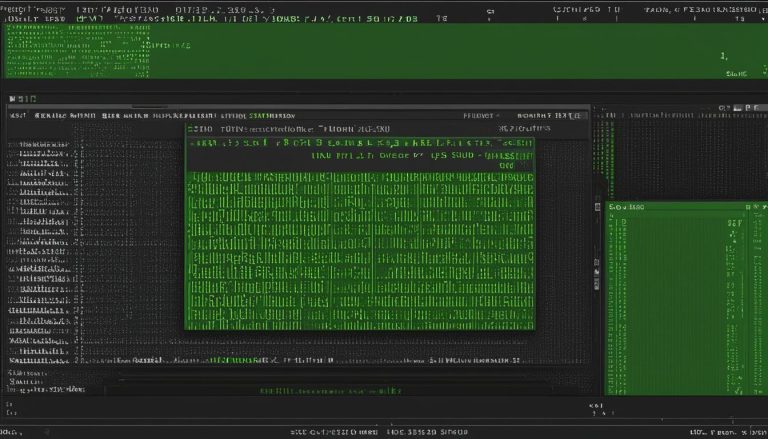As a journalist specializing in technology and operating systems, I’m often asked about different Linux distributions and their unique features. Today, let’s delve into the world of Arch Linux and explore what sets it apart.
Arch Linux, an open-source operating system, offers users unparalleled versatility and customization options. It is renowned for its stability and security, making it a popular choice for servers and critical systems.
When it comes to the Linux user interface, Arch Linux provides the freedom to choose from various distributions, with GNOME and KDE Plasma being among the most popular desktop environments.
Key Takeaways
- Arch Linux is an open-source operating system known for its versatility and customization options.
- It is highly customizable, allowing users to tailor it to their liking by modifying its appearance and adding or removing features.
- Arch Linux is stable and secure, making it ideal for use in servers and critical systems.
- The Linux user interface can vary depending on the distribution chosen, with popular desktop environments being GNOME and KDE Plasma.
- Exploring Arch Linux provides users with a personalized computing experience and a deeper understanding of the Linux ecosystem.
The Power of Open Source
When it comes to Linux, one of its defining characteristics is its open-source nature. The code of Linux, including Arch Linux, is freely available for anyone to view, modify, and distribute. This open-source philosophy fosters collaboration and innovation, as developers and users come together to improve the operating system. The power of open source lies in the collective efforts of a global community, where individuals can contribute their expertise and insights to enhance the software.
With Arch Linux being open source, users have the freedom to customize and tweak their operating system to suit their unique needs. Whether it’s adjusting the appearance, adding or removing features, or optimizing performance, the possibilities are endless. This level of customization empowers individuals to create a personalized computing experience tailored to their preferences and requirements.
The open-source nature of Linux also contributes to its security and transparency. With the code being publicly available, any potential vulnerabilities or malicious intent can be quickly identified and addressed by the community. This collaborative approach ensures that Linux remains a stable and secure operating system, trusted by individuals and organizations alike.
Open source is not just about code; it’s about collaboration and the belief that by working together, we can achieve greatness.
The Power of Collaboration
Collaboration is at the heart of the open-source movement, and Linux epitomizes this spirit. The open-source nature of Linux encourages developers and users to come together to share ideas, solve problems, and collectively contribute to the improvement of the operating system. This collaborative effort leads to continuous innovation and the creation of various distributions or distros. Arch Linux, as one of these distributions, benefits from the collective wisdom and expertise of the open-source community.
Through collaboration, developers can pool their knowledge and resources to create an operating system that meets the diverse needs of users. It allows for the integration of cutting-edge technologies and features, ensuring that Linux remains at the forefront of innovation. This collaborative approach also fosters a sense of community, where individuals can support and learn from one another, making the open-source ecosystem a thriving and vibrant community.
Linux’s open-source nature and emphasis on collaboration are what sets it apart from proprietary operating systems. By harnessing the power of open source, Linux and distributions like Arch Linux empower individuals to take control of their computing experience, fostering a sense of ownership and creativity.
The Diversity of Linux Distributions
One of the most remarkable aspects of Linux is the sheer variety of distributions or distros available. Each distribution has its own unique features, design choices, and target audience. Ubuntu, Fedora, Debian, and Linux Mint are just a few examples of the diverse array of distributions that exist within the Linux ecosystem.
| Distribution | Key Features |
|---|---|
| Ubuntu | Known for its user-friendliness and long-term support |
| Fedora | A cutting-edge distribution embraced for its innovation and constant updates |
| Debian | Often called the universal operating system, offering stability and versatility |
| Linux Mint | Prioritizing simplicity and elegance with its user-friendly interface |
These distributions cater to different needs and preferences, providing users with a range of options to personalize their computing experience. Whether it’s a focus on stability, user-friendliness, or cutting-edge features, there is a Linux distribution for everyone.
Exploring different distributions, like Arch Linux, allows users to discover the nuances and strengths of each, enabling them to find the perfect fit for their specific requirements. The diversity of Linux distributions is a testament to the flexibility and adaptability of the open-source philosophy.
Arch Linux: Versatility and Stability
Arch Linux is renowned for its versatility and stability, making it a popular choice for a wide range of applications. Its flexible nature allows it to be used not only on personal computers but also on servers, mobile devices, and embedded systems. This adaptability enables users to harness the power of Arch Linux across various platforms, ensuring consistency and reliability in their computing experience.
When it comes to servers, Arch Linux’s stability shines through. Its robust architecture and streamlined design make it an excellent choice for hosting websites, managing databases, and running critical applications. The stability of Arch Linux ensures that servers can operate seamlessly, minimizing downtime and providing a reliable platform for businesses and organizations.
Furthermore, Arch Linux is well-suited for mobile devices. Its lightweight and efficient nature enable it to run smoothly on smartphones and tablets, offering a secure and responsive user experience. By leveraging Arch Linux’s stability, mobile devices can benefit from enhanced performance and optimized resource management, allowing users to stay productive on the go.
In conclusion, Arch Linux’s versatility and stability make it an exceptional choice for a multitude of use cases. From servers to mobile devices, its adaptability ensures a consistent and reliable computing experience. Whether you’re looking to host websites, manage databases, or power your mobile devices, Arch Linux provides the stability and performance needed to excel in today’s digital landscape.
Table: Arch Linux Versatility and Stability on Different Platforms
| Platform | Versatility | Stability |
|---|---|---|
| Personal Computers | Highly customizable, tailored to user preferences | Reliable and secure for everyday computing needs |
| Servers | Efficiently handles web hosting and critical applications | Minimizes downtime and ensures reliable server performance |
| Mobile Devices | Lightweight and optimized for smooth mobile experience | Secure and responsive platform for productivity on the go |
| Embedded Systems | Customizable for specific hardware and IoT applications | Ensures stability and reliability in embedded environments |
The World of Linux Distributions
When it comes to Linux, one of the most fascinating aspects is the wide variety of distributions available. Each distribution offers a unique set of features and benefits, catering to different needs and preferences. Here, we take a closer look at some popular Linux distributions, including Arch Linux, Ubuntu, Fedora, Debian, and Linux Mint.
Arch Linux
Arch Linux is a lightweight and highly customizable distribution that appeals to experienced Linux users. It follows a “do-it-yourself” approach, allowing users to build their system from the ground up. Arch Linux offers a rolling release model, providing users with the latest software updates without the need for major version upgrades. This distribution is ideal for those who want complete control over their operating system and enjoy the process of customization.
Ubuntu
Ubuntu is one of the most popular and user-friendly Linux distributions available. It focuses on simplicity and ease of use, making it accessible to both beginners and experienced users. Ubuntu offers a vast software repository, ensuring that users have access to a wide range of applications. It also provides long-term support (LTS) versions, guaranteeing stability and security for extended periods. Ubuntu is a great choice for individuals looking for a hassle-free Linux experience.
Fedora
Fedora is known for its cutting-edge features and frequent updates, making it a favorite among tech enthusiasts and developers. It has a strong emphasis on open-source software and serves as a testing ground for technologies that eventually make their way into other distributions. Fedora offers various editions tailored to different use cases, such as Fedora Workstation for developers and Fedora Server for hosting applications and services. If you’re looking for a distribution that embraces innovation and the latest advancements in the Linux world, Fedora is an excellent choice.
Debian
Debian is often referred to as the “universal operating system” due to its stability, versatility, and extensive package repository. It is known for its strict adherence to the principles of free software and aims to provide a reliable and secure platform. Debian serves as the basis for many other distributions, including Ubuntu. With its long history and commitment to community-driven development, Debian is a solid option for those who prioritize stability and a strong open-source ethos.
Linux Mint
Linux Mint is designed with user-friendliness and elegance in mind. It offers a familiar and intuitive interface, making it an excellent choice for those transitioning from Windows. Linux Mint provides a range of desktop environments, including Cinnamon, MATE, and Xfce, allowing users to customize their experience to suit their preferences. It also includes various multimedia codecs and popular software out-of-the-box, ensuring a seamless and enjoyable Linux journey.
These are just a few examples of the vast array of Linux distributions available. Whether you’re a seasoned Linux user or new to the world of open-source operating systems, there’s a distribution out there that suits your needs. Exploring the world of Linux distributions allows you to find the perfect match for your personalized computing experience.
| Linux Distribution | Key Features |
|---|---|
| Arch Linux | Highly customizable, rolling release model |
| Ubuntu | User-friendly, vast software repository, LTS versions |
| Fedora | Cutting-edge features, frequent updates, diverse editions |
| Debian | Stability, versatility, extensive package repository |
| Linux Mint | User-friendly, multiple desktop environments, multimedia codecs |
“Linux distributions offer a vast array of options for users to explore. Each distribution brings its own unique features and benefits, catering to different needs and preferences. Whether you’re a Linux enthusiast seeking customization or a beginner looking for a user-friendly experience, there’s a distribution out there for you.”
Getting Your Hands on Linux
When it comes to installing Linux, including Arch Linux, there are several options available to suit different preferences and needs. One popular method is setting up a dual boot system, which allows users to have both Linux and their existing operating system on their computer. This way, users can experience the power of Linux while still having the familiarity of their current OS. To set up a dual boot system, users need to partition their hard drive, allocate space for Linux, and then install the Arch Linux distribution of their choice. This option provides flexibility and the opportunity to explore Linux without fully committing to it.
Another installation option is to use a live USB. This method allows users to run Linux directly from a USB drive without the need for installation. It is a great way to test out different Linux distributions, including Arch Linux, without making any permanent changes to your computer. To use a live USB, users need to create a bootable USB drive with the Linux distribution of their choice, plug it into their computer, and then boot from the USB drive. This option is convenient for trying out Linux on different machines or even using it for troubleshooting purposes.
Whether you choose to set up a dual boot system or use a live USB, getting your hands on Linux, especially Arch Linux, opens up a world of possibilities. It allows you to explore the vast and vibrant Linux ecosystem, customize your computing experience, and tap into the power of open-source software. With Linux, you have the freedom to tailor your operating system to your specific needs and preferences, making it a popular choice for tech enthusiasts and professionals alike.
Arch Linux Installation Options Comparison
| Installation Option | Pros | Cons |
|---|---|---|
| Dual Boot | – Allows users to have both Linux and existing OS | – Requires hard drive partitioning – More complex setup process |
| Live USB | – No need for installation – Portable and can be used on different machines |
– Changes made during the session are not permanent – Slower performance compared to installed Linux |
The table above provides a comparison of the pros and cons of both dual boot and live USB installation options for Arch Linux. It can help you decide which method suits your needs best based on your preferences and the resources available to you.
In Conclusion
Exploring Linux, including Arch Linux, is an exciting journey that opens up a world of customization, versatility, and open-source collaboration. Whether you choose to set up a dual boot system or use a live USB, Linux empowers you to break free from the limitations of traditional operating systems and embrace the freedom to tailor your computing experience. So, go ahead, get your hands on Linux, and embark on a personalized computing journey like no other.
Conclusion
In conclusion, exploring the world of Linux distributions, including Arch Linux, opens up a world of possibilities for a personalized computing experience. Each Linux distribution offers a unique ecosystem that caters to different needs and preferences, allowing users to truly make their operating system their own. Whether you choose Arch Linux or any other distribution, the freedom, collaboration, and constant innovation that Linux offers will surely enhance your computing experience.
Linux distributions, such as Arch Linux, provide a wide range of options for users to break free from the limitations of traditional operating systems. The open-source nature of Linux fosters a vibrant community where users can collaborate, customize, and contribute to the improvement of their operating system. Whether you are a beginner or an advanced user, Linux distributions offer a platform for growth and exploration.
With distributions like Arch Linux, you have the power to shape your operating system to fit your needs and preferences. From a stable and secure foundation to the ability to customize every aspect of your system, Arch Linux empowers you to create a computing environment that is uniquely yours. So, embark on your Linux journey today and experience the freedom and flexibility that Linux distributions have to offer!
FAQ
What is Arch Linux?
Arch Linux is an open-source operating system known for its versatility and customization options.
What makes Linux open-source?
Linux is open-source because its code is freely available for anyone to view, modify, and distribute.
What are some popular Linux distributions?
Some popular Linux distributions include Ubuntu, Fedora, Debian, and Linux Mint.
How can I install Linux?
You can install Linux, including Arch Linux, by setting up a dual boot system or using a live USB.
Why is Arch Linux known for its stability?
Arch Linux is known for its stability because it is highly customizable and offers a stable and secure environment.
Hi, I’m Mark, the author of Clever IT Solutions: Mastering Technology for Success. I am passionate about empowering individuals to navigate the ever-changing world of information technology. With years of experience in the industry, I have honed my skills and knowledge to share with you. At Clever IT Solutions, we are dedicated to teaching you how to tackle any IT challenge, helping you stay ahead in today’s digital world. From troubleshooting common issues to mastering complex technologies, I am here to guide you every step of the way. Join me on this journey as we unlock the secrets to IT success.


